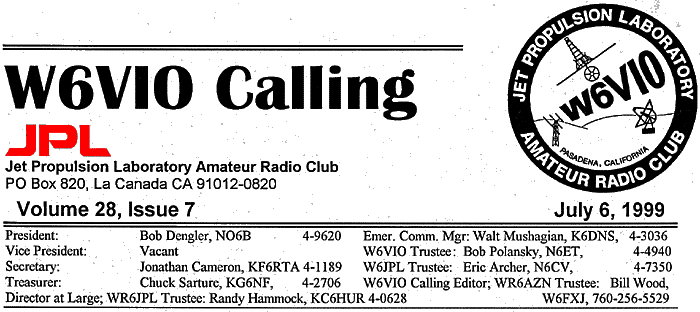Permission to copy is granted provided that credit is given to “W6VIO Calling.”
Contents
- Calendar of Events
- Meeting Notice
- Prez’ Mix
- June Club Meetings
- DX News
- Field Day, 1999
- Recap of Our Field Day Saga – As I Remember It
- Field Day Scrapbook
Calendar of Events
|
July 10 |
[Fontana Swap Meet, A. B. Miller HS, Fontana} |
|
July 14 |
General Meeting, Noon - 238-543 |
|
July 17 |
[CMRA Hamfest, Cal Poly, Pomona, 7 AM] |
|
July 28 |
Board Meeting, Noon - 233-305J |
|
July 31 |
[TRW Swap meet, Redondo Beach] |
|
August 11 |
General Meeting, Noon - 238-543 |
|
August 14 |
[Fontana Swap Meet, A. B. Miller HS, Fontana} |
|
August 21 |
[CMRA Hamfest, Cal Poly, Pomona, 7 AM] |
|
August 25 |
Board Meeting, Noon - 233-305J |
|
August 28 |
[TRW Swap meet, Redondo Beach] |
|
September 8 |
General Meeting, Noon - 238-543 |
|
September 11 |
[Fontana Swap Meet, A. B. Miller HS, Fontana} |
|
September 11 |
Angeles Crest Century Bicycle Race |
|
September 18 |
[CMRA Hamfest, Cal Poly, Pomona, 7 AM] |
|
September 22 |
Board Meeting, Noon - 233-305J |
|
September 25 |
[TRW Swap meet, Redondo Beach] |
Meeting Notice
The next regular JPL Amateur Radio Club will be held on Wednesday, July 14, at noon in Building 238 Room 543. The Club Board of Directors meetings are held at noon on the fourth Wednesday of each month in 233-305J. Everyone is welcome at both meetings; bring your lunch.
Prez’
Mix
By Bob Dengler, NO6B
It goes without saying that the big event of the month for the club was Field Day. From my FM-slanted point of view, things got off to a rough start as the station needed to be set up with only an hour and a half to go before the start of Field Day. Fortunately, things were under control in the HF department so Bob Polansky & Walt Mushagian were able to help get the station antennas set up & on the air quickly. The new Comet GP9 high-gain 2 meter/440 omni antenna was easy to assemble & raise due to its extremely light weight, and had fantastic performance.
Less could be said of the club’s Icom IC-275H, which held together for only a dozen contacts before the RF output power control gave out again. Fortunately, this was just long enough to work KC6ZME: 5A East Bay on Mt. Diablo, approximately 317 miles NNW of Mt. Gleason, east of Oakland! What was even more amazing was that Ed Adams, N6YN operating N2EW at KNBC studios in Burbank, heard the Mt. Diablo station. Unfortunately, his signal faded out before Ed could get a chance to work him. I noticed the signal from KC6ZME to be full-scale at first, then I observed very rapid QSB, just like mobile flutter. A few seconds later, he was gone. I think this may have been a meteor scatter contact as some visible meteors were observed that evening. It’s certainly the best DX I’ve ever worked on 2 meters.
Following this high point of Field Day, I suffered the low point: the 275H transmitter gave out, with no apparent backup radio available. Mike Tope had brought some spare items up on Friday, including a zip cord that just happened to have the proper 12-volt connector for my IC-32AT HT, & a 140 watt 2 meter amplifier. I had my wattmeter & cable box with me, so I hooked up my HT to the amp & got around 120 watts out, so I proceeded to work the next hour or two with my HT. The 275H still received fine, so I used it with a Yagi to pick up stations when my HT’s front-end was overloaded. By the time Chris Carson & Mike Tope arrived with badly needed backup radios, my HT was sizzling due to the high transmit duty cycle required of a true 2 meter Field Day contest station.
A fan also had to be suspended above the amplifier to keep it cool. While we only managed 200 contacts on 2 meters before the evening chow call, it was certainly a good experience in operating under adverse conditions. I believe HF overall fared much better as the 15 meter CW QSO rate was double that of 2 meter FM for the first 2 hours. Check out Jay Holladay’s column for more Field Day details.
During the contest, I was saddened to hear of the loss of 146.52 for Field Day use. In my opinion the contest rule banning the use of 52 makes no sense whatsoever. The contest rules state “Use of the national simplex frequency, 146.52 MHz, or immediate adjacent guard frequencies is prohibited. Contest entrants may not transmit on 146.52 for the purpose of making or soliciting QSO’s.
The intent of this rule is to protect the national simplex frequency from contest monopolization.” I fail to see the need to restrict where contesters may operate, especially when 146.52 makes just as much sense to solicit contacts as on 223.5, yet the rules also state “There are no restrictions on the use of 223.50 MHz.” Why isn’t the 2-meter SSB calling frequency banned? It appeared that most of the Field Day stations in Southern California agreed, as 146.52 was rampant with Field Day activity this year in spite of this rule.
In the past, contesters would stand by for the Sunday morning net formerly held on 146.52, so the “contest monopolization” argument is debatable. Now, 52 is hardly used at all. The argument has been made that 52 needs to be kept clear of contest stations so that it can be available for emergency communications. I for one would like to know just who is going to be listening to 52 during the contest if contesters aren’t allowed to make FD contacts there (I’ve heard FD stations handle emergency traffic on 52 before it was banned for FD). I put out a general call on 52 about an hour after some ARRL official was heard telling all the FD stations that they couldn’t make contacts there. Nobody answered after calling with over 1 kW ERP from Mt. Gleason at 6500 feet elevation.
146.52 is the national calling frequency for 2 meters. Forbidding its use means a few less QSO’s made than if 52 were available, yet the object of Field Day is to make as many QSO’s as possible; otherwise we wouldn’t bother putting up the biggest antennas we could manage. I encourage everyone to write to the ARRL contest advisory committee urging them to reinstate 146.52 as a valid frequency for Field Day use. Their names & addresses can be found at http://www.arrl.org/contests/cac.html 73 for now.
June Club Meetings
By Jonathan Cameron, KF6RTA
GENERAL MEETING, June 9
Bob Dengler opened the meeting at 12:13 AM. Those present included: Chris Carson (KE6ABQ), Bob Dengler (NO6B), Warren Dowler (KE6LEA), Rick McKinney (KA6DAN), Walt Mushagian (K6DNS), Scott Nolte (N6CUV), William Pickett (KF6WCX), Bob Polansky (N6ET), Chuck Sarture (KG6NF), Bob Stiver (KF6PSS), and Jonathan Cameron (KF6RTA).
Bob Dengler reported that a few operators who are using bad language are misusing the club’s 2m repeater on 147.15 MHz (WR6JPL). He heard reports of bad language on the repeater so he listened for a while. When he heard bad language, he shut down the repeater for the evening. Bob encourages us all to please listen and report any misuses. It is important, since the FCC can shut us down if the repeater is misused and not under apparent control.
Bob Dengler reported that he has installed the pre amp for the 447.65 MHz repeater and it works well. He is continuing work on RLC3 but it isn't quite ready for installation. The new shift to 447.320 MHz for WR6AZN at Table Mountain (required by the recent SCRRBA ruling) caused an intermodulation product that bothers the 145.28 repeater input when all three TMO repeaters are on. We have requested a new frequency from SCRRBA.
Bob Polansky - Field Day Report
Bob reported on the field day preparations. The plans call for us to operate under the W6VIO call sign with Novice/Tech operations under Ross Snyder's call sign, N0GSZ. Other details on that can be seen in another section of this edition of W6VIO Calling. He noted that an article on the Field Day was submitted to the JPL Universe for future publication. We are looking for a solar powered rig in order to get 100 bonus points for solar powered contacts. Warren Dowler volunteered to supply it and help perform the necessary operations to get our Solar-powered-station points. Bob is expecting fair weather and predicts fun for everyone.
Walt Mushagian - Emergency Operations
Eric Fuller and the Security team are moving into new security building around the end of June. They are making preparations for HF/VHF/UHF operations as part of the new facility. The emergency net on Monday at Noon has been going well.
Scott Nolte - Membership
Scott reported finding some antenna bases that might be of use to the club. They are on JPL near building 103 and are apparently in the process of being surplused.
Chuck Sarture – Treasurer. Chuck Sarture reported reported that the club budget is in good shape.
Other items of note:
The cherry picker is being surplused due to damage. But we may be able to get a 50-foot cherry picker from Goldstone. It was noted that the radio odds and ends that we were planning to sell for operating funds will probably not be sold this year because the people involved simply don't have time to do it.
The club extended congratulations to Bill Pickett for his new amateur radio license, KF6WCX
BOARD OF DIRECTORS MEETING, June 23
The meeting was convened at approximately 12:20 PM. Those present were Bob Polansky (NO6B), Walt Mushagian (K6DNS), Jonathan Cameron (KF6RTA), and Bill Wood (W6FXJ, via telephone).
Bob Polansky reported on field day preparations. More detail can be seen in other parts of this newsletter.
Jonathan Cameron reported that the heightened security at JPL has prevented the standard letter for off-site members from being approved in the usual way. The new policy forbids anyone from entering lab without an official badge. During regular hours, getting visitor clearance through the visitor center seems possible, be we are still trying to work out a solution for what to do for off hours. Jonathan will work with security and the members affected to come to a satisfactory arrangement. In the mean time, if the members affected want to come on lab during regular hours, please call Jonathan Cameron at 818-354-1189 and he will help make temporary arrangements.
DX NEWS
By Bob Polansky, N6ET
Field Day is over and I just got the best two nights of sleep in several weeks. Now I can go back to concentrating on DX again. The solar flux hit over 200 today for the first time in many years. We can expect some pretty great conditions, especially with low “A” and “K” indexes. Thanks to the information provided in the 59(9) DX Report and QRZ DX, we have advance warning of the following operations, which should keep the HF bands hopping for a bit:
ANGOLA - D2GG has been reported on 17,12, and 10 meters. No frequencies or times given, but the path between the West Coast and West Africa on those bands is open most midmornings.
IRAN - If you have a good beam and a location with low angle visibility toward the north, you should listen for EP2MKO on the low end of 15-meter CW from 0230 to 0430Z. He’s on frequently, but I’ve yet to copy him. Lots of W6’s have worked him at that time.
LIBYA - 5A1A has been worked in California on 18095 kHz at 1340Z. There’s a find if you’re real lucky!
ALYJ VYSOTSKIJ - R1MVA will open on 4 July and will continue operation through 15 July. It sounds like they should be able to run up to six stations simultaneously with all the rigs, antennas, and generators they will have in place. The 25 operators promise lots of “R1” QSO’s!
MONGOLIA - Five JT stations will be active from 2 to 6 July, with JA hams behind the mikes and keys. If you miss them, JT1DA is frequently on in the late afternoon around 18070 kHz.
OMAN - A45XR made a W6 QSO at 0030Z at 18083 kHz. He’s been reported several times now around that time and frequency.
PALESTINE - If you missed the flurry of recent activity from the new Palestine “entity,” E4/JM1LJS will give you another chance from 23 July through 1 August. Please advise me if you hear this operation on CW. I managed to miss the last ones on that mode.
RODRIGUEZ ISLAND - 3B9FR has been worked in W6-land at 1330Z on 7009 kHz. He’s been reported on the low end of 40 meters several times now. He’s also been reported on 14025 kHz at 1240Z (a bit early for us) and at 18080 kHz at 1430Z (this may work).
SAINT PAUL ISLAND - If you missed both of the recent Saint Paul Island operations, CY9CWI will give you another chance from 21 to 28 July. Look for an all band, all mode operation. Give me a call if you hear them on 12 or 10 meters.
ZAMBIA - 9J2BO and one other 9J2 station have been reported from 0400 to 0500Z on both 12 and 17 meters. Listen over the long path. You might be surprised!
Enough for now. I’ve given you a good shopping list of fine DX to chase. The rest is up to you.
Field Day 1999
By Jay Holladay, W6EJJ
Although the JPL ARC/Caltech ARC Field Day 1999 had a few rough spots, in the end things worked out well and we achieved good results.
Most of the problems occurred prior to or early in the contest. The primary difficulty was that we were short-handed during our early activities, both while packing up at JPL and during setup at the Mt. Gleason site. The lack of people at the site on Friday was compounded by one of our key people being ill and having to return home until Saturday morning. As a result, we were only able to get one antenna tower up on Friday night and therefore were extremely rushed and pressed for time on Saturday morning.

(photo by Chris Carson, KE6ABQ)
Other than that, things actually went well during setup. The antennas were assembled and raised rather easily, thanks to all the work that has been put into the lifting and cradle arrangement for the Yagi antennas in recent years. We had monoband yagis for 40 through 10 meters, and the effort paid off once we got fully operational in the contest. In addition, we had beautiful weather for the weekend. Everyone seemed to like the new site layout, with the kitchen and mess hall on top of the hill near the operating tents. A large sun canopy that only came down once during the weekend - due to the winds on Friday night provided relief from the Sun.
Having to put up the second antenna tower array on Saturday morning left us really scrambling to complete the setup. We also had to finish configuring the computers and the CW keying setup, with the result that we were still getting the second HF station, as well as the VHF station, operational at the 11:00 AM contest start time.
We soon had things up and running properly and began a good run of contacts on one of the stations. As usual, rates seemed to start out a bit slowly. Fifteen meters was great, but on 10 propagation was spotty, and 20 was a bit slow as the East Coast and Midwest worked each other through the Field Day QRM. Later in the day 20 came into its own, and our efforts were much aided by the great 20-meter beam put together by Bob Polansky, N6ET, and Warren Dowler, KE6LEA. It has four wide-spaced elements on a 40-foot boom, and really performed like a champ once the propagation improved for the West Coast.
The late night crew also enhanced our effort this year. Stan Sander, N6MP, and Bob Deen, N5DPU, volunteered for the graveyard shift and kept both HF stations hopping during the midnight to 6AM shift, ably shifting between 80, 40, and 20, phone and CW. On VHF/UHF, our Pres., Bob Dengler, NO6B, put his operational skills and knowledge of the bands to work, garnering 250 contacts on 2-meters, 220, and 70 cm.
Another Field Day feature that kept us going from Friday to Sunday was the great meals prepared by Robb Fredrickson, W1EEL. Robb kept us well fed despite a very painful back problem. On Saturday night Jonathan, KF6RTA, and Janet Cameron pitched in to provide the crew with a delicious dinner.
Finally, in contrast with last year, we DID have enough help this year to make tear down go much faster and be a more pleasant experience. Special thanks to Mike Tope, W4EF, for all his hard work in putting together the Caltech ARC part of our effort, and to Bob Polansky, for carrying the majority of the load in the JPL ARC preparations this year despite an impending wedding in the family (the weekend after Field Day, yet!)
The preliminary score we worked out right after the contest ended showed some 200 contacts less than last year, but we also had 200 more CW contacts (which count twice as much as phone contacts), so the overall point score was a bit higher than last year. So, despite a slow start, we should finish in the top 20 in our class (out of 600 entrants). Not bad for a kind of pickup effort, and the crew are already saying, “wait ‘till next year!” [Final results will appear in next month’s W6VIO Calling.]
Recap of Our Field
Day Saga — As I Now Remember It
By Warren Dowler, KE6LEA,
Tuesday, June 22nd
Finished gamma match capacitor and attachment hardware for the 20 meter. Start to gather some of my tools and gear together—make a list of stuff to take. Plasma cut four 8-foot long stakes into two 4 foot ones to replace bad tower guy stakes. Saw cut Fly poles and welded on end pieces for attaching the Fly fabric. Found my new larger tarp--20 by 30 feet. Get a full roll of ¼-inch poly rope at Harbor Freight for $11 to tie down fly.
Wednesday, June 23rd
Tow Dave’s tower trailer from Caltech to home for checkout. Fill gas tanks on way home--20 gallons should do it; will siphon from cars if more gas is needed. (Used only 12 gallons for the three days) Check for trailer tongue weight. Yi! The tongue has over 300 lbs. Start charging the generator battery. What, it’s only taking 5 amps? It is a good battery. Empty the boxes and find a leaking oil bottle in oil soaked box—oil crept out from loose cap on top during year of storage. Check engine oil level—full. Prime gas line with gas tank in line pump. Start generator; it starts in less than 15 seconds of cranking. Check for voltage at duplex outlets, check circuit breakers. Light a 300-watt lamp on each circuit. Drain warm oil in generator, and change to fresh. Checked air filter. Pump up tires to 35 PSI. Calculate that my SUV and trailer will not hold all of the volume for Gleason. Have to put much of it in top rack of SUV.
Thursday, June 24th
0830: Cut all stakes to 45 inches long so they will fit flat into boxes. Cut trailer board pads so they will also fit flat in box. Decide to pack stakes onto trailer rear to decrease tongue weight. Also added two batteries and gas can to rear—tongue weight down to 150 lbs. Trailer can be packed.
1400. It’s hot now; start assembly of box for top of SUV. Planned one hour for this chore.
2000, Sun is down, box is on SUV with new-engineered tie down design. Lost the five hours planned for packing. Still have not gathered everything.
Friday, June 25th
Midnight. Gathered tools, etc. Now it’s all together but SUV not packed.
0300. SUV packed; drive to Caltech parking lot for a little sleep and wait to meet with Mike in morning.
0600. Awake to hear Mike W4EF, calling me on 440 as agreed, but my 440 won’t activate the repeater—must have an old PL. Oh well, will use the cell phone to his house—rings, no answer. Mike must have left, will just wait until he arrives.
0630. Mike arrives, but has migraine, he decides to take trailer up the hill anyway and then return home for some rest. We get two 2- meter rigs working on simplex
0730. Trailer is now on Mike’s truck. We pick up some medicine for Mike at his house. We are now on our way to Gleason with Mike in the lead. At Lake Avenue the 210 freeway is packed full, but cars are flowing; after the 134 turnoff traffic is nil. In La Canada we stop for gas and get some snacks. Forget about breakfast!
0800. Now on our way up to our annual hilltop field day, some construction crews on highway, but no wild drivers like two years ago. There also is no traffic following me.
0900. At Mt. Gleason road turnoff, I take the lead from Mike. Pit stop to check trailers, etc. Meet some BIG Forest Service Fire Trucks on curve. The dirt road around county jail is not very dusty this year, and the air is much cooler. First hill climb; now I have the SUV in first gear, floor boarded and am making less than 10 mph, but we finally make the crest of the second long grade.
0930. Mike unlocks the gate and we proceed to the Field Day flat area. The air is cool, but the sun is hot. With aid of Bob’s great layout map and my compass we position Mike’s trailer, then position mine to face beams to northeast.
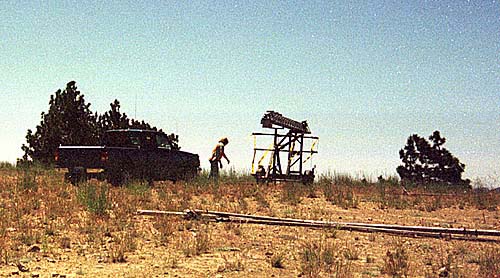
1000. Call on 224.70 to let those down below know that we are ready to assemble station. Find out that the port-a-potty is on its way, and some others should be along in about 15 minutes. It was a long 15 minutes.

1030. The port-a-potty arrives and is positioned. Almost the comforts of home.
1100. The antennas are unloaded and parts are placed on the ground; stakes, ropes, etc are also dispersed. By 1130 Mike has his trailer leveled and tower going up.

Noon. The second trailer is level, tipped upright and ready to go up. Gas cans in position and one is connected; generator can now be started at any time. Robb Fredrickson, W1EEL with the food arrives. Some help also rolls in, and finally the JPL Van arrives.
1300. It is HOT in the sun, So start to assemble Fly. Up it goes to produce shade; it is cool under the fly. Lunch and water is served.
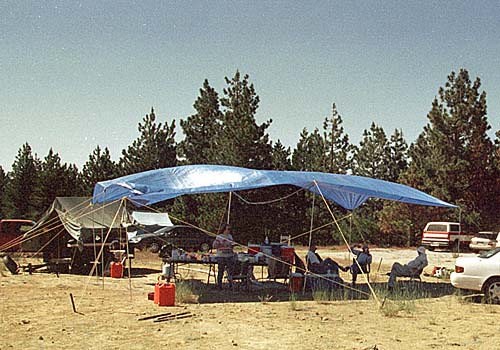
1600. Towers and guy ropes are positioned. Antennas are being assembled. Jay climbs 70-foot tower and UP THE FIRST ONE GOES. Have problems with boom rotation. Needed to have tag lines on the elements before we lifted it. The second antenna is then hoisted and mounted on tower with any problems. Team is now experienced and working well together.

1800. The second tower antennas are ready to go up, but it will be too dark soon to properly finish this tower; will have to wait until morning to lift them. Its time for dinner. Generator is running to cool Robb’s refrigerator, and we also have lights for the night.
2200. It’s now time for some sleep.
Saturday, June 26th
0500. What a soft sleep on the new air mattress in Bob’s tent. What! The Fly is DOWN? Another Gleason Friday Night Wind! Will fix fly after the antennas are all up.
0900. The 20-meter 4-element is ready to position on top of southwest trailer; we decide not to use gamma match, just coax choke coil. Have no problem with controlling beam rotation with two tag lines. Second small beam is lifted. Finally the HF antennas are up.
1000. Time to get the Fly repaired and up again for lunch. Binding rope failed at northwest corner. Cut new center pole for the bent one. With a lot of duct tape Fly is up again. Dave Ritchie claims it will fail and fall again with wind tonight unless we use triangle rope ties at each corner. Yellow rope is now everywhere, but no one trips over it. (It worked; Fly stays up until teardown on Sunday.)
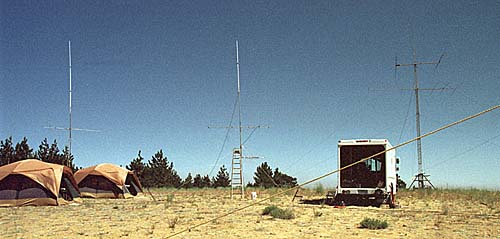
1115. One HF station is operating, and Bob Dengler, NO5B has the VHF/UHF operational. The novice station needs a 220 antenna, and the 6 meter is still in the box.
Noon. Time for lunch.

1300. Novice station is set up on 10 meter; need 220 antenna.
1500. 6-meter station is set up with battery and solar panels. However, only local contacts. All our stations are operating.
1900. Time for a great dinner prepared by Janet and Jonathan Cameron, KF6RTA. It’s three + courses, from snacks to desert. Lots of food. Oh! What great hot French/Italian Bread.
2300. Time for some sleep.
Sunday, June 27th
0600. Awake. The Towers and Fly are all standing up. Why is the wind so kind to us on Saturday night? It must know that people are awake all night and it would be a waste of its effort to try to blow us down!
1115. The big event of this Field Day is the arrival of Dave Kichtings, WD6V in his helicopter. Dave is friend of Walt Mushagian, K6DNS.
His copter appears as a dot at 11,000 feet just after we dropped the two towers. He lands on the lower east knoll. We invite him to have lunch, but Dave has visited several of the Field Day Stations located in the mountains and must take off to see some more.
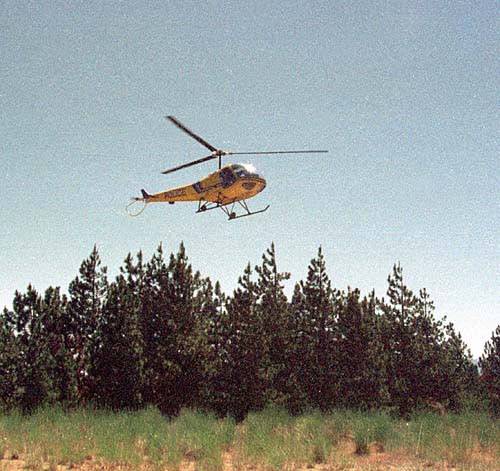
Noon. Jay Holladay, W6EJJ announces at lunch he has 2550 tally for contacts; many are CW—more than last year. Very Good show for 2A.
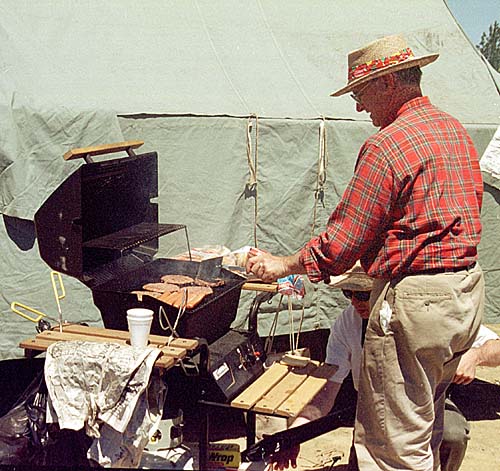
Robb Fredrickson, W1EEL, cooking
his last Gleason Meal
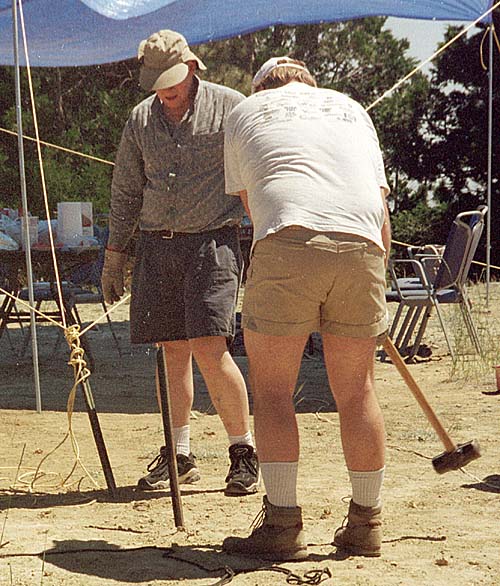
1500. Towers are down; all of the stakes are out—no bent ones this year.
1600. Packed up and on the road down the hill in low gear. Can also smell the hot brakes. Slow, steady, ride to JPL. Traffic was light until Angles Crest Highway. No construction workers today. Check weight on JPL scale: total weight up the mountain was 8060 lbs. with 2980 lbs. on the trailer.
1800 Home for a shower and some rest.
2000. Ladders off the trailer and unpack the SUV into house with wife’s help. Will sort it tomorrow. Dirty clothes into laundry. Ah, some more sleep.
Monday, June 28th Do some sorting; spend balance of day resting, reading unopened mail, and at the computer for e-mail.
Tuesday, June 29th Emptied the generator gas tanks, packed the trailer boxes. Will leave the stakes on the rear of trailer for tongue balance next year—tongue weight is 140 lbs.
Wednesday, June 30th Return trailer to Caltech parking lot. Return found stuff: JPL ¼” drill bit, Jay’s channel lock pliers, and Chris’s book to Ham Shack for them to pickup.
Thursday, July 1st Replace spare tire and take Mike’s spare tire weight to his house on way home. Return Caltech radios to ham shack.
Field Day 1999 is now history.
Field Day Scrapbook
Photos by Chris Carson, KE6ABQ
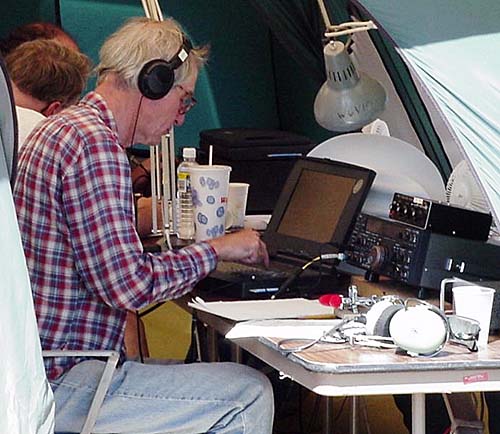
Jay, W6EJJ – a virtuoso on
the key or the keyboard
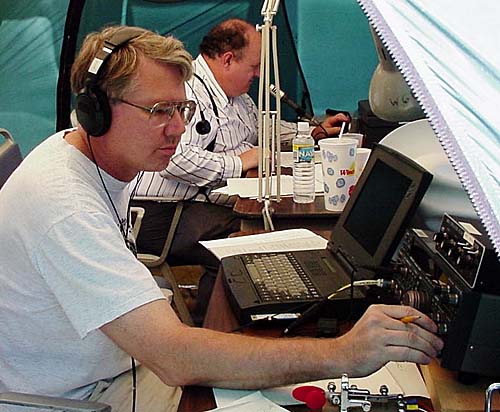
Foreground: WB6CIA on your radio
dial. Background: KF6RTA

Open Air Dining, No Crowds
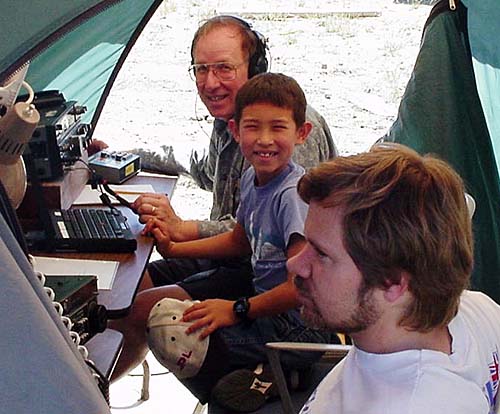
Ham Radio’s FUN: Stan, N6MP,
son Steven, and Bob, NO6B

Warren, KE6LEA, working the 6-meter
solar powered station
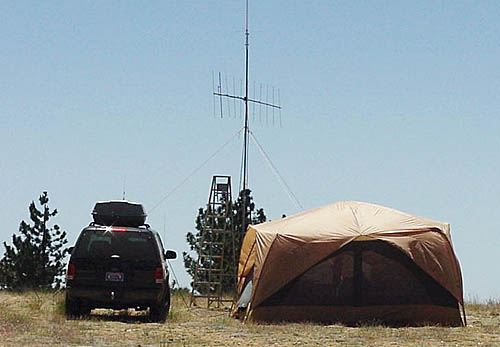
VHF Station Tent and Antennas

Sunset on Mount Gleason
Newsletter Deadline
Friday, July 30 for the August issue of W6VIO Calling. Your articles, ads, photos, diagrams, letters to the editor, or technical material should be submitted to the editor via email (w6fxj@earthlink.net) or regular mail to: Bill Wood, 31094 Hemlock Ave, Barstow, CA 92311.
Jet
Propulsion Laboratory Amateur Radio Club
Attn: Bill Wood, Editor,
Mail Stop DSCC-33
4800 Oak Grove Drive
Pasadena, CA 91109-8099
![]()
Updated August 11, 1999
